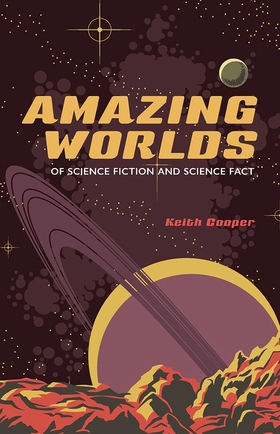Centauri Dreams
Imagining and Planning Interstellar Exploration
Focus on Alpha Centauri
At Palo Alto’s superb Amber India, I was thinking about Alpha Centauri. There are several Amber India locations in the Bay area, but the Palo Alto restaurant dishes up, among other delights, a spicy scallop appetizer that is searingly hot and brilliantly spiced. Greg and Jim Benford were at the table, Claudio Maccone and my son Miles. It was the night before Breakthrough Discuss convened. And while the topics roamed over many aspects of spaceflight, it was that star system right here in our solar neighborhood that preoccupied me.
How lucky could we be to have not one but two stars this close and so similar to our own? Centauri A is a G-class star, Centauri B a K, and if we hit the jackpot, we could conceivably find planets orbiting both. Then there is Proxima Centauri, an M-dwarf that is the closest star of all to the Solar System. The presence of so many astronomers on the Breakthrough Discuss roster made it clear we’d get the latest on the hunt for planets here, a vital factor as we assessed prospects for the Breakthrough Starshot mission. A nice blue target world would help.
The Binary Star Factor
Growing up, I would haunt the local library for books on astronomy, learning that despite its tantalizing proximity, Alpha Centauri was likely devoid of planets because Centauri A and B were so close to each other. After all, at times they close to within 11 AU — how could planets exist in such a gravitationally unsettled region? The question is still unanswered, as is the question of whether Proxima Centauri is truly part of a triple star system or simply shares a common motion with A and B. But our picture of Alpha Centauri has changed radically since my days in the local library, and the system is under scrutiny as never before.
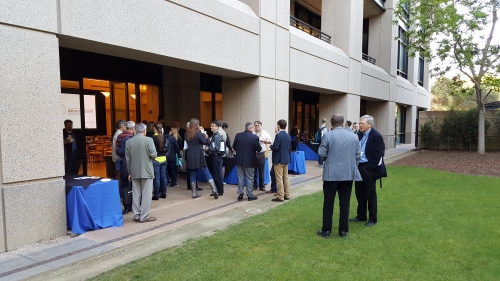
Image: Gathering outside Stanford’s Arrillaga Alumni Center with coffee in hand as we waited for the first session of Breakthrough Discuss to begin.
Paul Wiegert and Matt Holman discussed stable orbits around Centauri A and B back in 1997, work that led to a generally accepted belief that out to a distance of perhaps 2.5 AU, small planets of Earth-like radius or a bit larger could exist. Giant planets are seemingly ruled out by radial velocity studies, although Jared Males (University of Arizona) would note that we might save James Cameron’s Polyphemus, a gas giant in the film Avatar, by postulating a large radius, low mass planet. But he was quick to add that the prospect was not likely.
The session, titled Exoplanet Detection Programs Focused on Alpha Centauri, was led by Olivier Guyon, but it was Michael Endl (University of Texas at Austin) who presented the overview of Alpha Centauri work so far. The issue of planet formation is far from settled, and as Centauri Dreams readers know, the question is not so much one of stable orbits but whether planet formation can deliver an intact planet in the first place. Key work here has been done by Philippe Thébault and Javiera Guedes, who have reached opposite conclusions, with Guedes arguing for small planet formation, and Thebault arguing against the proposition because of planetesimal encounters and the impact velocities at which they would occur.
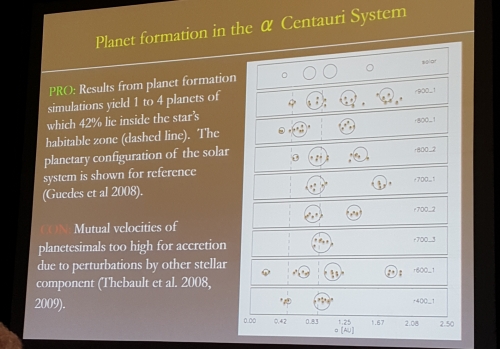
Image: One of Michael Endl’s slides, this one discussing planet formation around Alpha Centauri.
The argument will be settled, as Endl pointed out, by our increasingly powerful ability to deploy new technologies. Radial velocity methods are pushing toward the region we’ll need to study, but even now we would need to work at a 10-12 centimeters per second level to find an Earth mass planet, a feat that Endl noted was orders of magnitude below what today’s best instruments can deliver. Remember, too, that the planet we thought we had found around Centauri B probably isn’t there, now considered to be a false positive probably caused by activity on the star itself. In fact, let me quote Xavier Dumusque on this, as he was at the conference and was on the team that performed the original Centauri B work:
We worked with 20,000 spectra on Centauri B taken over four years and found a small 50 cm per second signal that seemed to be a planet in a 3.2 day orbit. Subsequent papers have shown that the signal is in the data, but it is probably not due to a planet. All our techniques are at the limit of their capabilities, which means we should use all the techniques we have, so that if one tells us we have a planet, another can assure us it is real.
The problems Alpha Centauri presents, particularly right now, are manifest. Spectral contamination means that when you’re trying to tease a Doppler signal out of the light from a star like Centauri B, you get light mixing in from Centauri A, for at this point in their orbits, the two stars have closed to their closest point as viewed from Earth. The work Dumusque referred to, drawn from HARPS spectroscopic data at the European Southern Observatory’s La Silla Observatory, may well have been affected by magnetic effects on Centauri B’s surface. But right now we’re in that period when the primary Centauri stars are very hard to analyze.
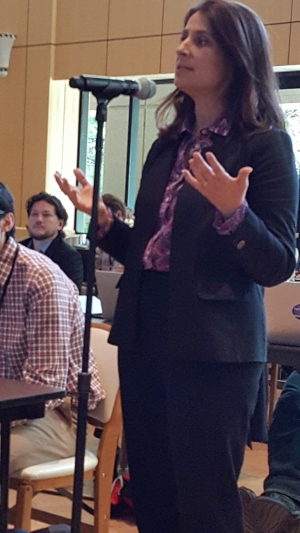
I’ll remind readers that there has been one possible transit detected. Motivated by the HARPS work on the possible 3.2-day period planet, the search turned up what looked like the transit of an Earth-like planet with a period of less than 12 days, but if it was a transit, it did not recur. As to Proxima Centauri, we still have no planets there, but we can rule out larger worlds, while allowing the possibility of planets of two to three Earth masses in the habitable zone. We’ve followed the work of the Pale Red Dot project that has collected new spectra using the HARPS instrument in these pages and are awaiting the data analysis with great interest.
Image: Natalie Batalha (NASA Ames) raising a point during the panel discussion that followed the Alpha Centauri planet detection talks.
Bringing New Methods to Bear
The point that Michael Endl made, and it was echoed by other speakers, is that we need to throw everything we have at this intractable problem. One way forward is to keep improving radial velocity precision, but we also need to do x-ray monitoring of Centauri A and B to look for activity cycles, and consider the possibilities of astrometry and even direct imaging. Thomas Ayres (University of Colorado) noted the dramatic changes to Alpha Centauri A in x-ray imaging — the star goes dark at x-ray wavelengths in 2005 with an unprecedented darkening by a factor of 50, and is now showing a return to activity levels close to that of our own Sun.
The scientists at Breakthrough Discuss were generally upbeat about the prospects of finding planets in the Alpha Centauri system, though the feeling was not quite unanimous, with Peter Tuthill (University of Sydney) saying he found the likelihood of planets there in the range of 20 percent. Adding “I’ve just put myself out of a job with that comment,” he went on to explain JAM, the JWST Aperture Mask, which would use astrometric methods to look for the tiny stellar motion that a planet tugging either Centauri A or B would induce. A separate mission called TOLIMAN (a medieval name for Alpha Centauri) would use a diffractive pupil aperture mask, with the distortions optical systems produce becoming a ‘ruler’ that detects such motion.

Image: A view across the way from the alumni center during a break. After the intense sessions, it was a pleasure to walk outside for a few minutes to rest my eyes.
And what about observing Alpha Centauri planets from the ground? We’re moving into the era of enormous ground observatories with apertures from 20 meters up to 100 meters across in the works. These Extremely Large Telescopes (ELTs), like the European Extremely Large Telescope (Chile), the Thirty Meter Telescope (Mauna Kea, Hawaii) and the Giant Magellan Telescope (Chile) point toward future instruments as enormous as Colossus, a 100 meter telescope concept that could become the world’s largest optical and infrared instrument.
Needless to say, such instruments can become major tools for studying planetary systems around nearby stars. But as Markus Kasper (European Southern Observatory) explained, we can also perform upgrades on existing instruments — the Very Large Telescope (VLT), Magellan (Chile) and Gemini (sites in Hawaii and Chile) — to perform pathfinder work at thermal infrared wavelengths for future imaging with the giant instruments to come. Thus ground-based instruments become a complement to space telescopes for actual exoplanet imaging.
I was interested in Bruce Macintosh’s presentation on direct imaging from space, because years ago I talked to Webster Cash (University of Colorado) about the prospects of using a starshade, in which the optics for a mission are separated. Rather than using a coronagraph to block out the light of the central star, you create a starshade whose shape is precisely determined to block the same light, with the starshade operating some 25000 kilometers away from the telescope.
Macintosh (Stanford University) said the problem of seeing a planet next to the blazing star that it circles was akin to looking for bioluminescent algae next to a lighthouse, which is why we need a coronagraph or a starshade in the first place. The WFIRST mission (Wide-Field Infrared Survey Telescope), scheduled for launch late in the next decade, will carry an advanced coronagraph, but a starshade would also be compatible with this instrument.
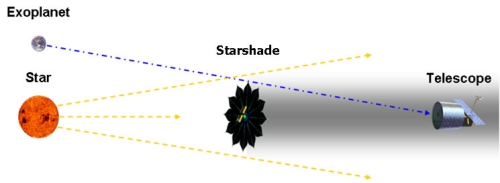
Image: The starshade in position far from the space telescope observing the light, with the central star effectively masked. Credit: University of Colorado.
But maybe we don’t have to wait that long. During a break I had the chance to talk to Cash, who had been a huge help with my original Centauri Dreams book. Cash has been working with starshade concepts for a long time, but even he was surprised when his team began testing small starshades in the atmosphere. In a field of view that included the bright star Sirius, the star would simply disappear. While continuing work on a space telescope/starshade concept called the Aragoscope (after French optical scientist Francois Arago), Cash and team began testing an airborne starshade that could be observed by a telescope on the ground.
All of this could lead to serious results at Alpha Centauri. Cash hopes to use an airborne starshade no more than a meter across that will be observed by a balloon-lofted telescope several hundred kilometers away to probe the habitable zone of Alpha Centauri. “Anything you can do on ground, you should do on ground,” Cash explained. “If we can do it remotely with big telescopes, it’s not a key part of payload that actually goes to Alpha Centauri.”
I’m running out of time today, so I’ll start tomorrow with an Alpha Centauri observing platform called ACEsat, a dedicated space observatory, and move from there into some of the more speculative thoughts of the attendees on what we might find around these stars.

Breakthrough Discuss: Initial Thoughts
The Breakthrough Initiatives conference I’ve just returned from, called Breakthrough Discuss 2016, had been a bit of a puzzle going in. Still bleary after an early morning arrival in Palo Alto, I was looking forward to getting to the Stanford campus for the first sessions the next day. Breakfasting at a small cafe near the hotel, I mulled over the possibilities. The emphasis was on astronomy, given the list of attendees, which included top names in the exoplanet hunt, but of course Breakthrough Initiatives is also funding a major SETI effort, so that would be a theme. And then there was the looming presence of the just announced Breakthrough Starshot.
Balancing all this out looked to be a challenge, but as it turned out, there was a strong cross-pollination among the various themes, with the Starshot — an unmanned flyby of Alpha Centauri and an infrastructure to sustain a further interstellar effort — woven into the proceedings. I knew I’d come back with material for a week’s worth of Centauri Dreams posts, but the level of presentations was so high and the insights so numerous that I’m thinking we’ll be talking about this meeting for some time to come. The challenge for me will be to weave ongoing news items into the background narrative the conference provides.

Image: Conference goers gather at Stanford’s Arrillaga Alumni Center just before the sessions begin.
The overall themes we would be dealing with were announced early. Jill Tarter was in charge of the SETI component, which focused on optical SETI and the detectability of directed energy systems, although in dealing with these issues you naturally get into broad questions of SETI strategy. Olivier Guyon, a coronagraph specialist who leads the Subaru Coronagraphic Extreme Adaptive Optics effort, led the sessions on exoplanet detection, which focused tightly on Alpha Centauri. Harvard’s Avi Loeb chaired the session on the Sun as a gravitational lens and gave a rousing conference keynote, one I’ll want to talk about in some detail later.
The gravitational lens was of particular interest to me. I ran into Claudio Maccone while checking into the hotel and we talked about the emphasis on a gravitational lens mission that was built into the program. Having championed the mission he’s been calling FOCAL for many years now, Claudio was clearly pleased at the attention the concept is now receiving. We’ve been talking about a FOCAL mission for years on this site with the assumption that it would involve a decades-long journey to the Sun’s gravitational focus, which begins at about 527 AU and for various reasons is best used a bit further out (more on this later). But now we’re talking about Breakthrough Starshot, a mission that could get to the focus in a matter of days.

Let’s back up a moment. The Breakthrough Starshot Concept uses the beamed power of a massive phased laser array to drive small sails to one-fifth of the speed of light in mere minutes. That gets you to Alpha Centauri in about twenty years, a mission time that compares suitably with other lengthy missions already in our portfolio, most especially Voyager. If we built the infrastructure to make this happen and solved the innumerable details that make it so difficult, we could get payloads to the gravity focus not only to conduct surveillance on our first target star, Alpha Centauri, but also to operate as a communications bridge between the Earth and Centauri A and B. Because as we’ll see, even a tiny transmitter can be detected at interstellar distances when you’re taking advantage of the massive magnifications at the gravity focus.
Image: Pete Worden, executive director of Breakthrough Initiatives, discussing the goals of the conference as it begins.
Thus FOCAL suddenly becomes a mission enabling technology in its own right, with not only a huge scientific payout but an engineering application for sails we might send out within a generation. But can we send them? At the Yuri’s Night festivities held at Yuri Milner’s estate, core Breakthrough Starshot participants discussed the mission and did a Q&A session with the audience, led by Milner himself. I’ll have more on all this as this series of reports continues, but for now, realize that a key part of the presentation was a list of 19 challenges the concept must overcome. How to build the beamer itself. How to power it up. How to ensure sails are not blown off its beam. How to get data back to the Earth. How to cope with interstellar dust.
As became evident in the discussion both at the Yuri’s Night party and during the conference at Stanford, no one is taking these problems lightly. The $100 million that Milner has put forward toward Breakthrough Starshot is to be used to dig into these key questions, to stress the concept to the breaking point, identify its weaknesses and learn how to resolve them. Will there be a genuine show-stopper somewhere in this investigation? At this point we can’t know, but we’ll have the research funding now to identify them if they are there. And as we are talking in generational terms, we’ll also identify the trends that may make the improbable possible.
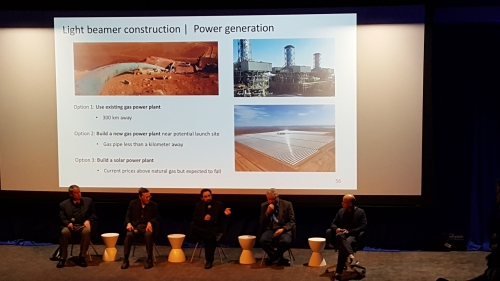
Image: Discussing Breakthrough Starshot with the audience during the Yuri’s Night celebration.
I have many thoughts on all this, but tomorrow we’ll start digging into the conference proceedings to see how Alpha Centauri shapes up as a target. As the nearest stars, Centauri A and B are irresistible targets, two stars each capable of hosting habitable planets, not to mention planetary possibilities around Proxima. But how much do we know about the system, and what are our next steps as we try to find out whether interesting planets are actually there? These issues and FOCAL’s contribution to an interstellar mission will take up much of the week. And that leaves us with optical SETI to examine by week’s end and the implications of beamed energy. If we use beamed power to propel spacecraft, can we detect others who do so?

On Track for ‘Breakthrough Discuss’
Expect no new posts until Monday and a slowdown in comment moderation as I attend the Breakthrough Initiatives event in Palo Alto. As has been my practice at previous such events, I won’t try to cover the talks and discussions live. While ‘live blogging’ has its place and seems to work for things like product introductions, I don’t find it useful for scientific conferences, where I need to take lots of notes and think about the implications of what I’ve written. But I’ll come back from Stanford with plenty of things to talk about, and we’ll use all of next week sorting them out. Dinner tonight with Jim and Greg Benford, my son Miles, and my old friend Claudio Maccone, with whom I’ll be talking SETI, the FOCAL mission (to the Sun’s gravity lens), and the best methods of data retrieval for a mission like Breakthrough Starshot. Many more good discussions ahead. SETI is a big part of this conference, but Alpha Centauri looms large.

The Odds on Starshot
Yesterday’s announcement of Breakthrough Starshot brought an email from exoplanet hunter Greg Laughlin (UC-Santa Cruz), whose work has been an inspiration to me since the early days of Centauri Dreams. One of Greg’s new projects, working with Anthony Aguirre (Foundational Questions Institute) and several other colleagues, is a website called Metaculus, which bills itself as “a community dedicated to generating accurate predictions about future real-world events by aggregating the collective wisdom, insight, and intelligence of its participants.” In other words, this is a kind of prediction market space for science and tech issues.
Breakthrough Starshot fits the bill here exactly, because Metaculus is all about the probability of future events, some of which can be predicted to a high degree, while others are purely a matter of calculated odds. The site is open to all and contains the basic information about its methods, and any logged in user can propose a question for consideration. Starshot comes into play through a series of four questions now available under the category ‘To the stars!’:
- Will the private investment in laser-sail extra-solar travel be matched by a comparable amount within 5 years?
- Mountaintop lasers, rockets, optics and wafers? Or something else?
- Will a first test of a high-power phased array laser system occur by 2018?
- Do potentially habitable planets exist in orbit around Alpha Centauri A or B?
The questions are now active on the site, and I think you’ll enjoy having a look and perhaps getting involved with your own predictions. It’s interesting to cull through the other questions as well ranging from discoveries at the LHC to the Turing Test. As the site notes:
Like many mental capabilities, prediction is a talent that persists over time and is a skill that can be developed. By giving steady quantitative feedback and assessment, predictors can improve their skill and accuracy, as well as develop a quantified track record. Then, probabilities of future events can be reliably drawn by optimally aggregating predictions — counting more heavily those with domain expertise and a strong prediction track record.
An Interstellar Swarm
Dennis Overbye is one of our most incisive science writers. I’ve profited from his work ever since his Lonely Hearts of the Cosmos (HarperCollins, 1991) and continue to read him in the New York Times. And it doesn’t surprise me at all to find that Breakthrough Starshot has triggered his usual elegance in the essay Reaching for the Stars, Across 4.37 Light-Years:
If it all worked out — a cosmically big “if” that would occur decades and perhaps $10 billion from now — a rocket would deliver a “mother ship” carrying a thousand or so small probes to space. Once in orbit, the probes would unfold thin sails and then, propelled by powerful laser beams from Earth, set off one by one like a flock of migrating butterflies across the universe.
That lovely image reinforces what some of us believe, that swarms of spacecraft, offering crucial redundancy and working at the far edge of miniaturization, are the most promising technology for deep space exploration at this level of our development. Milner’s advisers, who include Avi Loeb (Harvard), Pete Worden (former director of NASA Ames), Saul Perlmutter (UC-Berkeley), Freeman Dyson (IAS, Princeton) and Ann Druyan (producer of Cosmos), clearly agree, despite costs that will eventually reach $5 billion to $10 billion.
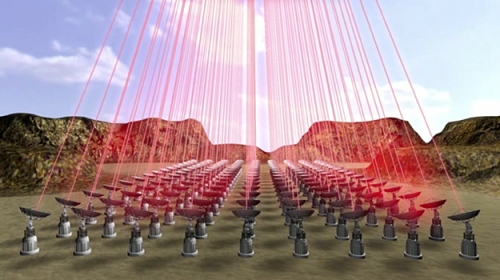
Image: A phased laser array, perhaps in the high desert of Chile, propels sails on their journey. Credit: Breakthrough Initiatives.
Given that the phased laser array Milner contemplates would have to generate 100 gigawatts of power for the crucial two minutes of acceleration on the sails, the task ahead is daunting. Thousands of lasers, as Overbye notes, will have to fire in perfect unison, and because this is a beamer built on the Earth, adaptive optics will have to compensate for atmospheric distortion. Moreover, we have to design a sail that will ‘ride’ the beam rather than be blown off it, and one that will be so highly reflective that it will absorb less than 1/100,000th of the energy applied to it.
These are problems that Robert Forward faced with his Starwisp design, a kilometer-wide ‘spider web’ of a sail driven by microwaves, with sensors scattered throughout the sail itself. It was Geoffrey Landis who would go on to show that as described, Starwisp would likely vaporize under the powerful beam meant to drive it to Alpha Centauri, causing a flurry of re-thinking of sail materials and design. But leaving the fuel at home is a powerful technique, and advances in technology may get us to the kind of materials that can withstand the photon torrent.
Writing for The Atlantic, Ross Andersen describes the sail this way in Inside a Billionaire’s New Interstellar Mission:
Picture a thin disc about the size of a round picnic tabletop. It would have miniaturized electronics onboard, including a power source, cameras, photon thrusters for navigation, and a laser for communication. Some of this kit would be bundled into the disc’s center, and some would be distributed through the rest of the sail. But it would all be a single unit: If you saw it streaking by, it would look like a flat, round sheet of reflective material.
We’ve also got a problem in that concept, because Jim Benford has pointed out that a flat sail is not a good ‘beam-rider’ — we’ll likely have to look at the kind of curved sail designs both Jim and brother Gregory Benford have studied in lab work at the Jet Propulsion Laboratory. But get a sail under that beam successfully and it reaches Pluto the day after launch, as Andersen notes. Another 20 years and it’s streaking through the Alpha Centauri system.
In any case, these are among the host of questions that the $100 million investment Milner is putting into the project will hope to answer, research extensive enough to offer proof of concept and finalize the design for a system that will eventually cost as much as the largest scientific projects we have built up to this time. A reusable facility may grow out of all this, one capable of sending fleets of small sails to our choice of nearby stars and returning imagery (the latter — data transmission at interstellar distances with craft this small — is another of the challenges that will have to be addressed. In a time of scaled-back thinking and low expectations, Breakthrough Starshot offers a sudden jolt of optimism that a new wave of research is on the horizon.

Breakthrough Starshot: Mission to Alpha Centauri
Here on Centauri Dreams we often discuss interstellar flight in a long-term context. Will humans ever travel to another star? I’ve stated my view that if this happens, it will probably take several hundred years before we develop the necessary energy resources to make such a mission fit within the constraints of the world’s economy. This, of course, assumes the necessary technological development along the way — not only in propulsion but in closed-loop life support — to make such a mission scientifically plausible. I get a lot of pushback on that because nobody wants to wait that long. But overall, I’m an optimist. I think it will happen.
Let’s attack the question from another direction, though, and leave human passengers for a later date, as Yuri Milner’s Breakthrough Initiatives, aided by Stephen Hawking, is doing today in a New York news conference. What if we talk about unmanned missions? What if, in fact, the question is: How soon can we put a scientific payload past another star? Let’s not worry about decelerating — this will be a flyby mission. Let’s build it as soon as possible using every breakthrough technology we have at our disposal. How long would it take for that mission to be developed and flown?

Milner, a philanthropist and investor who was an early backer of Facebook, Twitter, Spotify and numerous Chinese tech companies, tells me his goal is to ‘give back to physics’ in developing just such a mission. Part of that giving back is the $100 million he has already put forward to support SETI, a ten-year project that will produce more telescope time for SETI than any other. Milner is also the founder of the Breakthrough Prize, issuing awards in physics, life sciences and mathematics. But in many respects this third Breakthrough Initiative is the most daring of all.
Time for the Stars
Breakthrough Starshot is an instrumented flyby of Alpha Centauri with an exceedingly short time-frame, assuming research and development proceed apace. Milner is putting $100 million into the mission concept, an amount that dwarfs what any individual, corporation or government has ever put into interstellar research. A discipline that has largely been the domain of specialist conferences — and in the scheme of things, not many of those — now moves into a research enterprise with serious backing.
Could an Alpha Centauri flyby mission be developed and launched within a single generation? I think it’s quite a stretch, but it’s the best-case scenario Milner mentioned in a phone conversation over the weekend. He’s enough of a realist (with a first-rate physics background) to know that the challenges are immense. Even so, he sees no deal-breakers.
Let’s walk through the case and see why he finds reason for optimism. “There are major advances that we can now turn to as we develop this proof of concept,” Milner says. “Twenty years ago, none of these things would have been available to far-thinking scientists like Robert Forward. But now we can put them to use and test their possibilities.”
If you’re thinking of an interstellar mission in the near-term, there is really only one choice of propulsion: The beamed sail. Sails have the advantage of known physics, laboratory experiment and actual deployment in space. We could talk about fusion for some indefinite point in the future, but at present, we don’t know how to do fusion even in massive installations on Earth, much less in the tight confines of a spacecraft engine. Interstellar ramjets are a far-future unknown — they may act more effectively as braking devices than engines, according to recent research. Antimatter is nowhere near readiness for propulsion, either in production methods or storage. Chemical rockets fall victim to the mass/ratio problem and are useless for fast interstellar journeys.
That leaves us with sails carrying very small payloads. To cross the 4.37 light years to the Centauri A and B system, Breakthrough Starshot proposes small spacecraft, taking advantage of advances in nanotechnology to reduce payload size. Think Moore’s Law and the reductions in size and cost that have accompanied the vast increases in micro-chip power. “Moore’s Law,” says Milner, “tells us that now is the time.”
StarChip is the Breakthrough Initiatives’ name for a payload measured not in kilograms but grams, a wafer that carries everything you would expect in a fully functional probe. ‘What was once a 300 gram instrument is is now available at three grams,” Milner continues. “What was 100 grams is now 0.5 grams. This is the trend we are riding.”
The StarChip payload includes cameras, power supply, communications equipment, navigation capabilities and photon thrusters. And it would be thrown across the interstellar gulf at 20 percent of the speed of light by a sail that is itself a miniaturized version of the sails Robert Forward used to discuss. Forget the thousand-kilometer sail (much less the continent-sized sails of the science fiction dreamer Cordwainer Smith). Milner’s team believes we can now talk in terms of a laser-driven lightsail that is no more than 4 meters across. This is actually smaller than the first deployed sail craft, the Japanese IKAROS, which boasts a sail measuring 14 meters to the side.
Advances in metamaterials and additional research should be able to produce, Milner believes, a 4 meter sail whose own weight is tallied in grams, and whose materials allow fabrication at a thickness of a few hundred atoms. A sail that small makes its own statement: Clearly, it’s not going to be under the beam for long, which means we need to focus a great deal of light on it for a very brief time. Lasers are another technology that benefits from rising power and falling cost. The trick here will be to create ‘phased arrays’ of lasers that can scale up to the 100 gigawatt level. A phased array involves not one but a group of emitters whose effective radiation pattern is reinforced in the desired direction by adjusting the phase of the signals feeding the antennae.
This is classic Bob Forward thinking rotated according to the symmetries of our new era. Milner aims for a beamer technology that is modular and scalable. And it fits into a larger infrastructure. Breakthrough Initiatives talks about bringing a ‘Silicon Valley approach’ to the problem of interstellar flight. Build a StarChip that can eventually be mass-produced at no more than the cost of an iPhone. For the Alpha Centauri mission, whenever it flies, is itself a proof of concept that could lead to multiple destinations. And if the cost can be driven as low as Milner believes, then we can think in terms of redundancy, with StarChips sent in large numbers to return a full characterization of any destination system. Assemble the light beamer and, as the technology matures, the cost of each launch falls.
These are ideas that are at once familiar but also exotic, for while Forward talked about enormous power stations in close solar orbit to power up his banks of lasers (and a huge Fresnel lens in the outer system to focus the beam), Milner thinks we can build a ground-based beamer at kilometer scale right here on Earth. I was startled at the idea — surely efficiency favors a space-based installation — but Milner’s point is that he thinks we can begin to launch interstellar craft before we have the technology to build the kind of power station Forward envisioned. If you’re serious about a launch within a few decades (again, it’s a best case scenario, and a dramatic one), then you build an Earth-based beamer and use adaptive optics to cancel out atmospheric effects.
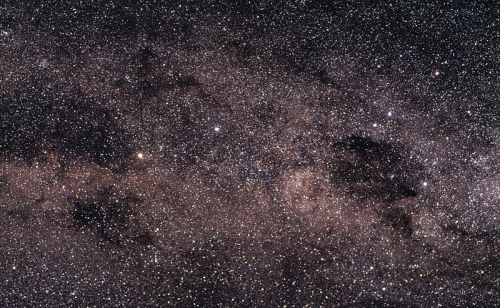
Image: A wide-field view obtained with an Hasselblad 2000 FC camera by Claus Madsen (ESO), of a region around the Southern Cross, seen in the right of the image (Kodak Ektachrome 200, 70 min exposure time). Alpha Centauri is the bright yellowish star seen at the middle left, one of the “Pointers” to the star at the top of the Southern Cross. Although it appears here as a single ‘star,’ it is actually comprised of the G-class Centauri A, K-class Centauri B, and the M-dwarf Proxima Centauri. Credit: ESO/Claus Madsen. Original here.
All this will be subject to tightly focused research, which is what the $100 million is for, but what Milner hopes to see are nano craft delivered to orbit and then boosted on their way with a 30 minute laser ‘burn’ that, reaching 60,000 g’s, drives the sail to 20 percent of the speed of light. That makes for roughly a twenty year crossing to Alpha Centauri. With a craft this small, data return is highly problematic, and in fact I think it’s one of the biggest unanswered questions Breakthrough Starshot will have to face (well, this and the challenge of interstellar dust, and key questions related to sail design and the sail’s ability to stay on thee beam during acceleration). The sail is itself the antenna on a craft of this design, and Jim Benford told me in conversation that it will have to be shaped to one-micron precision. Even so, powering up the system to send imagery and data to Earth is going to be tricky. It will be fascinating to see what kind of solutions emerge as this research gets underway, and what alternative methods may be suggested.
Even so, and granting the cost reductions digital technology makes possible, Breakthrough Starshot embarks upon a multi-year research and engineering phase that will focus on building a mission infrastructure. Creating the actual mission will demand a budget comparable to the largest scientific experiments of our time. These are no small aspirations, but what drives them is something that interstellar studies have never had at their disposal: A dedicated, enthusiastic, well-funded effort with the participation of major scientists.
“We have an advisory board of twenty, including Freeman Dyson and other top scientists,” Milner added. “$100 million will be spent in coming years as we look toward concept verification. Multiple grants should flow from this, research and experiments. We need to complete the initial study and see if building a prototype, perhaps at a scale of 1/100, is then the next step.”
At the very least, we can expect the research behind this project to spin off numerous useful technologies, all of which should be applicable not only to star missions but to in-system exploration, along with, potentially, a kilometer-scale beamer that can double as a large telescope for astronomical observations. And while I doubt we can look at interstellar missions within the next few decades (I am open to being convinced otherwise), I believe that the timing for a fast flyby of Alpha Centauri will be considerably advanced by this work.
There is much to be said about all aspects of the Breakthrough Starshot concept, and as you would imagine, I’ll be covering this closely, beginning with a trip later this week to the Breakthrough Initiatives meeting in California. That meeting will have a large SETI component growing out of Milner’s prior commitment of another $100 million, which is already being translated into active observations at the Green Bank observatory in West Virginia. But as you can imagine, the Alpha Centauri mission will be under discussion as well as the research effort begins to be assembled. What spins out of this will keep us talking for a long time to come.

The Snowbank Orbit, Redux
We haven’t yet found Planet Nine, but the evidence for its existence is solid enough that we can start thinking about its possibilities as a mission target. That work falls in this essay to Adam Crowl, a Centauri Dreams regular whose comments on articles here began not long after I started the site. An active member of the Project Icarus attempt to re-design the 1970s Project Daedalus starship, Adam is also the author of Crowlspace, where his insights are a frequently consulted resource. Today he harkens back to a 1960s science fiction story that has given him notions about a way not only to reach Planet Nine but to establish orbit around it.
by Adam Crowl

Fritz Leiber is better known for his fantasy and SF-fantasy, but he could write hard-SF too. A fine example is his 1962 story, “The Snowbank Orbit”, the title of which alludes to World War II tales of pilots surviving bailouts without parachutes by plunging into snow-drifts. Five spacecraft, racing towards Uranus at 100 miles per second with empty tanks, intend a fiery plunge through the planet’s atmosphere to brake into orbit. The rest of that story I will leave to the interested reader [available here] but the idea of aerobraking into orbit around a distant Planet Nine is worth discussing.
Presently we know very little about Telisto – the mellifluous name suggested for Planet Nine by physicist Lorenzo Iorio [1] which I’ll use for convenience. Brown & Batygin [2] suggest an orbit averaging about 700 AU and a mass of at least 10 Earth masses. The mass could be somewhat higher, though certainly not of the order of a Saturn-mass as its infra-red glow would’ve been seen by earlier surveys. Modelling [3] suggests a 10 Earth-mass planet, with a substantial hydrogen-helium envelope, could be as ‘warm’ as 50 K – about 40 degrees warmer than the ~10 K from sunlight alone. A range of compositions were modelled. A Super-Earth, an Ice-Giant (like Uranus/Neptune) and a miniature version of Jupiter/Saturn are all possible. Some cosmogonic simulations [4] suggest a Neptune like object is likely to have been flung from amongst the other giant planets during their formation, so it seems the most likely option.
A Neptune-like Telisto would then be an ice-wrapped rocky core wrapped in a layer of captured hydrogen/helium mixture. It’s likely that hydrogen will be depleted from its atmosphere by some fraction being chemically bound and mixed with its core, so helium will be a higher fraction of the atmosphere, as appears to be the case for Neptune. If the atmosphere is a small fraction of Telisto’s mass, then it’s possible it will have an icy surface or even a liquid water ocean under a hydrogen atmosphere via its greenhouse effect trapping the planet’s internal heat. In that case Telisto will be very interesting from an astrobiological perspective, though the energy sources available to sustain life are impossible to quantify at present.
Telisto, at 700 AU, would be in interstellar space, well beyond the moving boundary of the Sun’s magnetosphere, so its intrinsic magnetic field would dominate over a vast volume of space. The raw flux of impinging cosmic rays might allow enhanced creation and trapping of antimatter, as suggested occurs around the planet Saturn and the Earth. Any moons of Telisto would also provide a ready source of materials, if we chose to build starships there.
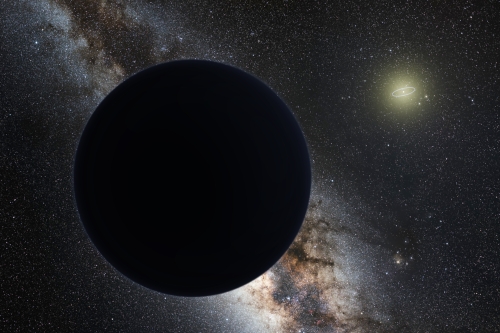
Image: Artist’s impression of Planet Nine as an ice giant eclipsing the central Milky Way, with a star-like Sun in the distance. Neptune’s orbit is shown as a small ellipse around the Sun. The sky view and appearance are based on the conjectures of its co-proposer, Mike Brown. Credit: Tomruen, nagualdesign; background taken from File:ESO – Milky Way.jpg (Own work) CC BY-SA 4.0, via Wikimedia Commons.
Deep Space Propulsion
Given sufficient motivation we’ll send a probe and eventually follow in person. Getting there will be a challenge. At the present 3.5 AU/year of “Voyager 1” the journey would take 200 years. Leiber’s 100 miles per second would get a probe there in 20 years, which might be acceptable if the probe has a compelling secondary mission it can pursue during the long cruise phase. Long baseline telescopic observations might be sufficiently attractive to combine the two. A flyby at 100 miles per second is probably too quick to provide sufficient science return for the investment, so stopping will be required.
Conventional propulsion, such as nuclear powered ion drives, are unlikely to be up to the task. In 1987 the Thousand AU (TAU) probe to was studied as a first interstellar mission [6]. The eventual design chosen used a nuclear reactor that was technically not far removed from the SNAP reactors that had been tested in the 1960s. The ion-drive would run for a decade and the probe would take 50 years to reach 1,000 AU – without stopping. Ion drives have improved significantly since then and could bring the mission time down to 20 years. The chief performance limitation is power supply. Fissioning a kilogram of uranium produces about 90 trillion joules of energy, but the rate at which it can be released is limited by the maximum temperature at which the reactor can operate. Typically a power reactor runs at less than the melting point of the fuel elements and its components, especially when required to operate reliably for years at a time. Then waste heat has to be ejected into space, which requires heavy radiators. Minimising radiator size means the reactor’s power production cycle must convert raw heat into power at less than 25% efficiency, so 75% of the energy of fissioning uranium has to be dumped to space. Due to these limitations solid-core power reactors can supply power with a specific power of at most 50 to 100 watts per kilogram (W/kg) of reactor power-system.
To reach 700 AU in 20 years requires increasing the vehicle’s kinetic energy at the rate of about 470 watts per kilogram of vehicle. If the reactor power-system is a hefty 75% of the vehicle’s mass, then it must supply power at over 600 W/kg of total vehicle mass. Advanced ion drives typically can convert raw electricity into kinetic energy with an efficiency of between 75%-85%, so the total power supply from the reactor needs to be over 700 W/kg. No solid core reactor can run hot enough to achieve this. Reactors, in theory, can run hotter – much hotter. Liquid, gas or plasma core reactors have been researched, but require several decades of development to bring to operational readiness. As yet theoretical, Fission fragment reactors might also push performance beyond this level, though with similar development times.
An incredible nuclear fusion power source already exists in space – the Sun. Two torrents of momentum and energy stream out from the Sun, in the form of photons and the Solar-Wind, with a total power of 400 trillion trillion watts. Tapping just a tiny fraction of that torrent would allow a quick trip to Telisto – and the stars beyond. Doing so is the challenge. Solar-sail propulsion taps the photon torrent and is the option being vigorously tested by the Planetary Society, NASA and JAXA. Another option is the Electric-Sail, or E-Sail, which uses a multitude of long, thin wires that are charged so they reflect the charged particles of the Solar-Wind. E-Sails are being developed by a Finnish team led by Pekka Janhunen [5], with some NASA involvement.
A less well-developed option is the Magnetic-Sail (Mag-Sail), which uses a loop of superconducting wire to form a miniature magnetosphere to ride the Solar-Wind. Unfortunately the need for cooling systems for the superconducting wire makes the Magnetic-Sail less attractive for operation near the Sun. The Solar Wind itself is quite turbulent magnetically on the size-and-time scales relevant to interplanetary Mag-Sail applications, so considerable applied research into Mag-Sailing the Solar-Wind is needed before it can be used with confidence.
All Sail types will require a probe to closely approach the Sun to intercept sufficient photons or Solar-Wind (mostly protons and alpha particles). If the probe were to drop to 0.2 AU – half the orbit of Mercury – it would need to be pushed outwards with a force about 7 times greater than the Sun’s gravitational attraction at that distance to reach a final speed of 35 AU per year (i.e. 100 miles per second.) For a total mass of 500 kilograms the probe would need an E-Sail about 48 km across or a Solar-Sail about 700 metres across. Increasing the total mass will require proportionally larger sails of both kinds, though the exact final mass will depend on power sources and payloads chosen.
The Challenge of Deceleration
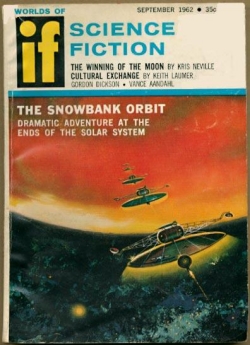
After cruising for 20 years, the probe then needs to stop, a non-trivial task. Telisto certainly isn’t radiating enough photons to slow a Solar-Sail, but the Interstellar Medium that it is embedded in might provide some drag for an E-Sail. Past the orbit of Saturn, the Mag-Sail’s superconducting wires would no longer need active cooling and the Interstellar Medium (ISM) is a calmer medium for Mag-Sailing. Thus a combination of E-Sail and Mag-Sail can be used. A Mag-Sail could form the outer ring to support the E-Sail and would only be powered up once the ambient temperature was low enough. For years there have been hints of high temperature superconductivity materials, so there might be a breakthrough at any time which would allow a purely Mag-Sail system, but it’s unnecessary at present. Before Aero-Capture at Telisto – the probe’s “Snowbank Orbit” maneuver – the Mag-Sail/E-Sail will need to be packed away or detached.
Image: Fritz Leiber’s “The Snowbank Orbit” involved aerobraking in the atmosphere of Uranus. Can we adapt these methods to Planet Nine, achieving a stable orbit for our probe?
Some speed will need to be shed in the atmosphere, but how much? The fastest re-entry ever survived was by the Galileo mission’s Descent Probe in 1996, which re-entered at a speed over 47 kilometres per second, surviving more than 200 gees of peak deceleration. That probe’s Thermal Protection System – an aerodynamic cone of material designed to ablate away absorbed re-entry heat – lost almost half its mass during its fiery plunge. An Orbiter doesn’t want to plunge all the way into Telisto, but shed sufficient speed to go into orbit. An initial capture can be a highly elliptical almost-escape orbit, with a short burn needed at its highest point (apoapsis) to raise the low-point (periapsis) of the orbit away from the planet into something more circular that doesn’t plunge back into the atmosphere.
A 10 Earth-mass Super-Earth Telisto with a relatively thin atmosphere – less than 0.1% of its mass – would need a capture speed of about 25 km/s. If a probe arrived at 50 km/s it would need to shed 75% of its kinetic energy to brake to 25 km/s. If the planet is rotating relatively quickly the relative arrival velocity will be reduced if the maneuver happens close to the equator – Galileo’s descent probe arrived at nearly 60 km/s, but Jupiter’s cloud tops rotate at 12.5 km/s, thus reducing the relative velocity to a more manageable 47.3 km/s. If Telisto were a mini-Neptune (mostly ices) or mini-Jupiter (mostly hydrogen/helium) then the planet will be significantly larger. Both compositions in this mass-range have been modelled. A Neptune-like Telisto would have a radius of about 4 times Earth, while a Jupiter-like Telisto would be more like 8 Earth radii. Required capture orbital velocity would be significantly lower – 18 km/s and 12 km/s respectively – but would have higher cloud-top rotation speeds for the same rotational period. A top re-entry speed of 50 km/s seems likely, but there is some research into magnetic braking in an outer atmosphere environment that may change that figure once matured.
A journey to Telisto is a stretch-goal for our aerospace technologies. Any suite of techniques that can place an orbiter there in 20 years, or less, is a breakthrough for all missions to the Outer Planets and beyond. In the wider historical context, we can liken Telisto to an over the horizon island that’s hinted at by flights of birds, a trick that ancient mariners used to guide them successfully to new lands. Star formation models suggest that the ISM is home to thousands of planet-like objects that formed from tidally disrupted proto-stars, a prospect strongly supported by microlensing data, though as yet only from the further reaches of the Galaxy. As microlensing surveys and techniques become more refined we will discover closer islands in the Dark Ocean between the stars. Getting beyond the noisy, obscuring Heliosphere will give us new means of detecting such worlds via their radio emissions and other disturbances of the ISM. Even long-range gravitational detectors could be deployed, away from perturbations from the flotsam and jetsam of the solar system. Colonizing Telisto’s likely system of moons would thus be the first outpost in a cosmic Ocean dotted by interstellar planets.
Reference Links
[1] http://adsabs.harvard.edu/abs/2015arXiv151205288I
[2] http://adsabs.harvard.edu/abs/2016AJ….151…22B
[3] http://adsabs.harvard.edu/abs/2016arXiv160207465L
[4] http://adsabs.harvard.edu/abs/2012ApJ…744L…3B
[5] http://www.electric-sailing.com/
[6] https://en.wikipedia.org/wiki/TAU_(spacecraft)

